The Cleveland Indians bullpen was a mess for much of the 2019 season. After adding several infusions of up-and-coming talent, they have a fascinating mix of veteran relievers who know their roles well, and young, electric arms that have top-level ceilings. If it all works, this could easily be one of the best bullpens in baseball, but there are a lot of potential outcomes here, especially since so much depends on the young bucks making a big leap.
| Closer | Setup | Setup | Middle | Middle | Middle | Middle | Long Relief |
|---|---|---|---|---|---|---|---|
| Brad Hand | Nick Wittgren | Emmanuel Clase | Oliver Perez | Adam Cimber | Hunter Wood | James Karinchak | Adam Plutko |
Closer – Brad Hand
2019 was a roller coaster season for Hand. He got off to a red-hot start, looking like he was on his way to a career year through April and May, putting up a 1.19 ERA with a 37.9 K% and 0.4 HR/9. Starting in June, though, everything fell apart, as he would manage a mere 4.67 ERA with a 32.9 K% and a 1.3 HR/9. What happened? In September, Hand was shut down by Indians manager Terry Francona and was sent for an MRI on his elbow, as Hand said it had been bothering him for a while. The scans came back clean and he was diagnosed with a tired elbow and didn’t pitch again in 2019. Following a pattern set by the collapse of Cody Allen and Andrew Miller in previous seasons, this does fall into a pattern of the Indians heavily using their best relief pitchers and then leaving them hard-ridden and put away wet. Allen and Miller never really recovered. I’ll be watching Hand closely in ST to see if he looks back on track.
If he does fully recover, just how good is Brad Hand? Very, very good. From 2016 through 2018, Hand threw 230.2 innings with 304 strikeouts, a 2.58 ERA, and a 1.04 WHIP. That includes a 24.3 K-BB%, a .195 BAA, and 3.08 FIP. His fastball and slider are his best tools and he uses them well, with his slider being a truly devastating strikeout pitch in particular.
 Brad Hand throws a pitch” width=”620″ height=”344″ />
Brad Hand throws a pitch” width=”620″ height=”344″ />
He has also averaged 29 saves over the past three seasons, and despite his struggles in 2019, he still was able to save 34 games in just 57.1 IP, so he can still be successful if they decide to scale back his innings from his usual 70+ inning workload.
Setup – Nick Wittgren
The Indians traded for Wittgren before the 2019 season. In his previous season with the Marlins, Wittgren had shown signs of finding himself by putting up a 2.94 ERA and a disproportionate 1.31 WHIP in 33.2 IP with 31 Ks. The Indians saw potential there and traded for him that offseason. He rewarded their faith by throwing for a 2.81 ERA and 1.08 WHIP with 60 strikeouts in 57.2 IP. What led to that success? Some of it is luck, given his .253 BABIP and 83.3 LOB%, but that’s not the whole story. In 2019, he added 5% to his strikeout rate and cut his walk rate nearly in half. Put it like this: He walked 15 batters in both 2018 and 2019. Thing is, he pitched twice as many innings in 2019 as he did in 2018. That’s a heck of an improvement.
With that being said, I have some concerns about Wittgren. His Statcast numbers are not great. There’s nothing to excited about in his 9.6 BBL%, 92.0 mph exit velocity, 15.6-degree average launch angle, or 49.4% hard-hit rate. When you consider that he only had a 38.1 GB%, that means his pitches are getting hit in the air and hit hard. I just don’t know if that’s sustainable. Wittgren is currently slotted in as the main setup guy for the Indians bullpen, but I’m skeptical he actually holds the job all season.
Setup – Emmanuel Clase
Emmanuel Clase is an electric pitcher with a ton of potential. He came over in the Corey Kluber trade, which I am still handling very well …
https://gfycat.com/impressivelonelydingo
That’s what you get for letting a theater kid write this: A Streetcar Named Desire references. Despite my broken heart, Clase could be really, really good. His calling card is a fastball/cutter that averages 99.4 MPH and has a ton of movement for a pitch that fast. Watch and weep at its beauty.
Weep I say!
Weeeeeeeeeep.
It’s such a filthy pitch; I don’t know how you even hit it. Here’s the weird thing: Batters did hit it in 2019. I mean, they didn’t hit it well (.249 xBA, 86.4 mph average exit velocity, 3.5 average launch angle, 58.2 GB%) but they did make contact with it at a 77.8% rate, and the pitch only registered a 22.5 K%. How is that even possible? While it seems baffling that such a nasty pitch doesn’t garner more strikeouts, the underlying stats show us the path to this becoming a truly dominant pitch. In fact, let’s do a quick blind comparison:
| Player | Pitches | Avg Velocity | O-Swing% | Zone% | Contact% | SwStr% | K% |
|---|---|---|---|---|---|---|---|
| Emmanuel Clase | 272 | 99.4 | 40.00% | 52.2% | 77.80% | 11.0% | 22.5% |
| Mystery Player A | 583 | 98.2 | 25.60% | 52.5% | 77.2% | 10.0% | 21.6% |
The numbers say it all. Note that Clase’s fastball qualified as a money pitch last year! Now, who is Mystery Player A? If you guessed Aroldis Chapman you’d be absolutely correct! It’s incredible how closely their fastballs resemble each other. Although I wouldn’t be doing my job if I didn’t point out that Clase gets a ton of swings out of the zone, at nearly double the rate of Chapman.
So what’s keeping Clase from turning into a clone of one of the most dominant closers of the last decade? It’s his slider. Much like his fastball, Clase’s slider drew a ton of poor contact (75.9 Contact%, .197 xBA, 86.4 mph average exit velocity, 1.6-degree average launch angle) but doesn’t get the strikeouts it should (21.4 K%). Now, on its own, this is great, and if Clase can continue to draw this sort of poor contact, he’ll be a very good reliever for a long time, but if he wants to take the leap into elite closer territory, he’ll need to start getting strikeouts with one of these pitches.
So how does he do that? I see two paths. Let’s start by taking a look at how and when he uses his two pitches.
| Pitch | Total | % Early in Count | % w/ 2 Strikes | % w/ Hitter Ahead | % w/ Hitter Behind | % w/ Even Count |
|---|---|---|---|---|---|---|
| Fastball | 272 | 71.6% | 26.1% | 29.4% | 25.4% | 45.2% |
| Slider | 73 | 63.0% | 37.0% | 6.8% | 39.7% | 53.4% |
The first path I see is to switch around how he uses his pitches with two strikes. If you recall from the Chapman comparison, Clase’s fastball had a 40 O-Swing% rate. Most of the time he is locating that outside fastball middle-in to left-handed batters in order to induce weak contact.
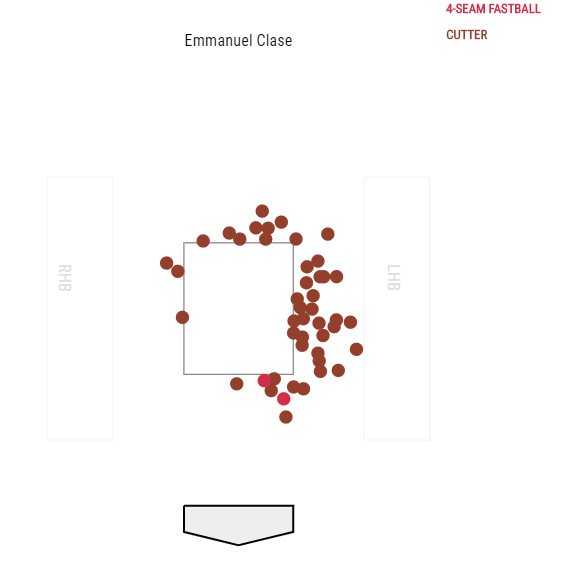 Emmanuel Clase’s fastball spray chart” width=”571″ height=”571″ />
Emmanuel Clase’s fastball spray chart” width=”571″ height=”571″ />
Perhaps part of the solution would be to include throwing the pitch up in the zone more often in order to get more whiffs. Either way, if the pitch is getting a 40.0% O-Swing rate, then using it more often in two-strike counts should lead to more strikeouts.
The other path involves where he locates his slider and how he uses it early on. He isn’t afraid to throw the pitch early in the count (63.0% of sliders thrown) and for strikes (40% of all sliders thrown early in the count), but they were a bit all over the place.
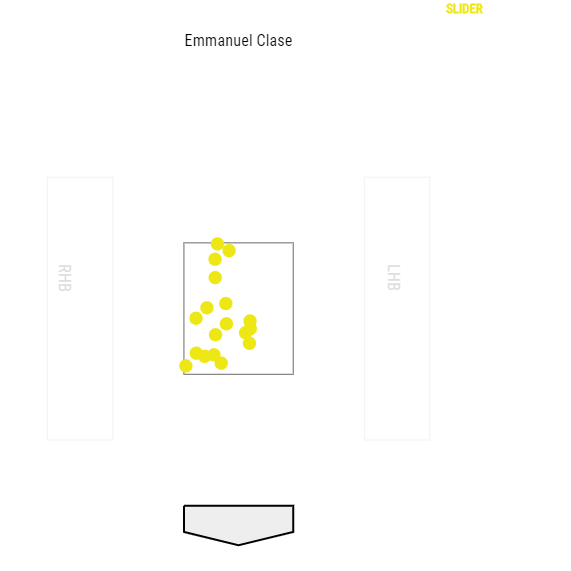 Emmanuel Clase’s slider spray chart” width=”571″ height=”571″ />
Emmanuel Clase’s slider spray chart” width=”571″ height=”571″ />
Only eight of these 18 pitches were in the bottom three sections of the zone (17% of all sliders thrown early in the count). Ideally, you’d like to see more of those pitches in the bottom of the zone. This way, when he throws his slider down and out of the zone, hitters are more likely to bite on it, because they don’t know if it will fall in the zone or not. Overall, 32 of the 73 sliders Clase threw were down and out of the zone (43.8%), but only 12 (16.4%) drew swings. It’s likely that he could get more chases on his slider if the ones he threw in the zone were better located. If we’re talking about revamping a slider, he’s in the perfect place to do it. The Indians have had a ton of success recently rebuilding pitchers sliders and are among the best in pitch design. If anyone can turn Clase’s slider into a lethal pitch, they can. If they do, he might end up an elite relief pitcher sooner rather than later.
Middle – James Karinchak
If Clase isn’t enough to get you excited about the future of the Indians bullpen, then James Karinchak will certainly bring you fully on board. Karinchak is another closer in the making and a pure strikeout machine. Check out the K% for each level he pitched at in 2019.
| Level | IP | K% | Ks |
|---|---|---|---|
| Rookie | 3 | 72.70% | 8 |
| AA | 10 | 66.70% | 24 |
| AAA | 17.1 | 53.90% | 42 |
| Majors | 5.1 | 36.40% | 8 |
That’s incredible. It doesn’t even do justice to just how good Karinchak could be. It was just 5.1 IP in the majors, but in that time he managed a 41.5 O-Swing%, 43.6 Zone% and a 16.0 SwStr%. It’s an incredibly small sample, of course, but for 5+ innings he was a walking money pitch. It’s easy to see why the Indians are excited about this kid. Let’s talk about his arsenal.
The fastball is Karinchak’s main tool, and boy is it a good one. It sits at 96.8 mph on average and he can seemingly blow it by anyone at will.
That’s a perfect fastball up in the zone to strike out Jose Abreu.
He can throw it down in the zone too, as he gets Juan Soto flailing at it. In 53 pitches, it managed three strikeouts, a .109 wOBA and -29 wRC+. Again, it’s a small sample, but it’s still pretty impressive. It has above-average movement as well, considering it moves about 6 MPH faster than the average four-seamer. All things considered, he has pretty good control over it, as evidenced by a 58.5% zone rate with his fastball. That being said, I would love to see him develop better command of the pitch.
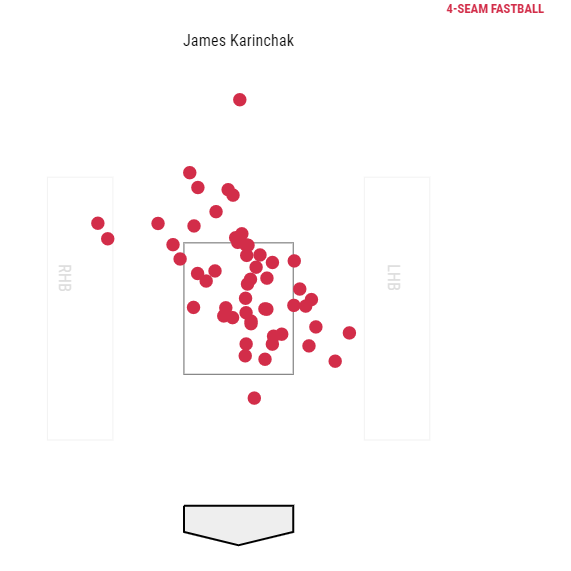 James Karinchak’s fastball spray chart” width=”571″ height=”571″ />
James Karinchak’s fastball spray chart” width=”571″ height=”571″ />
A few too many of these fastballs caught the center of the zone for my liking. If he can get a better sense of putting the pitch at the top or bottom of the zone, we could easily see him make the leap from thrower to pitcher pretty easily.
Now, what about that curveball?
It’s pretty.
Pretty filthy, that is. Karinchak’s curveball is a big curve with tons of strikeout potential. It has good movement vertically that starts at a batter’s head and ends up at his knees. In fact, it actually bears resemblance to another very famous curveball.
According to Pitch f/x, despite Kershaw being a southpaw, the movement profile on his curveball is nearly identical to Karinchak’s. If he can learn to locate it like Kershaw, the sky could be the limit for this pitch.
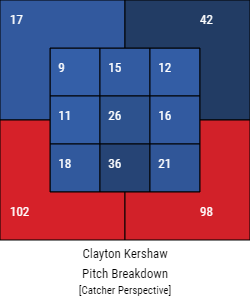 Clayton Kershaw’s pitch breakdown from the catcher’s perspective” width=”250″ height=”300″ />
Clayton Kershaw’s pitch breakdown from the catcher’s perspective” width=”250″ height=”300″ />
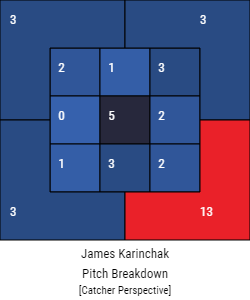 James Karinchak pitch breakdown from the catcher’s perspective” width=”250″ height=”300″ />
James Karinchak pitch breakdown from the catcher’s perspective” width=”250″ height=”300″ />
| Pitcher | % Bottom of Zone | % Down and Out of Zone | Combined |
|---|---|---|---|
| Kershaw | 17.80% | 47.50% | 65.30% |
| Karinchak | 14.63% | 39.00% | 53.63% |
Karinchak is well on his way to properly using his CU, but I would love to see him bump up those numbers to the same range as Kershaw. I sound like a broken record, but for pitchers with a dope curveball or slider, it is so important that you can throw it in the bottom of the zone for a strike. Two or three of those five pitches dead center drop down, and he’s right on track. Either way, it’s already a pretty devastating curveball and small improvements could put him into the elite reliever realm sooner rather than later. Roster Resource has Karinchak pretty far down the bullpen totem pole, but I’m willing to bet he’s sitting in Wittgren’s role by the All-Star break next year.
Middle – Oliver Perez
Oliver Perez is the Indians LOOGY, and he’s one of the better ones in the game. Facing 95 left-handed hitters in 2019, Perez gave up a mere 18 hits (.207 AVG, .264 wOBA) and a scant 4 ER (3 HRs). That means that he only allowed one inherited runner to score when facing a lefty. In addition, he averaged just over a strikeout per inning while producing a 52.5 GB% with a 16.7 IFFB%. That’s really good.
The problem is the way MLB handles relievers is changing drastically. As of this year, every relief pitcher is required to face at least three hitters or pitch through the end of an inning. This is going to severely limit Perez’s usefulness because he gets absolutely mashed by right-handed hitters. The 78 righties that he faced hit .278 off him with a .358 wOBA, while Perez gave up 14 of his 18 earned runs against RHH. This doesn’t bode well for him. I love Perez and enjoy rooting for him, but I worry that this new rule is going to tank his 2020.
Middle – Adam Cimber
Adam Cimber really struggled last season after a pretty promising 2018 season. His biggest issue is he simply doesn’t miss enough bats out there with his 16.8 K% and 80.9 Contact%. Combine that with a far too high walk rate (7.8 BB%, and his 43.2% zone rate was down 8% from 2018) for that low of a K% and a near 0.99 HR/9, and you can see how he ended up with a 4.45 ERA. The thing is, it’s not all bleak for the Submariner. Cimber was top 40 among relievers in BBL%, and had above league average marks in hard-hit percentage, exit velocity and launch angle. It’s entirely possible that if he can find the zone more often and cut down on the walks, then that soft contact could translate into better results for him in 2020.
Middle – Hunter Wood
26-year-old Hunter Wood made big improvements in 2019, as he’s dropped his ERA all the way down from 2018’s 3.73 to 2.98, and his WHIP plummeted from 1.46 to 1.28. Unfortunately, it’s all a bit of smoke and mirrors. After the All-Star break, Wood fell apart, putting together a 3.80 ERA over 21.2 IP with a ludicrous 2.11 HR/FB and 1.41 WHIP. That lines up pretty well with what he had managed the year before. So what holds Wood back? It’s mainly his terrible fastball. This Fangraphs article by Pitcher List alumnus and all-around dope guy Michael Augustine does a great job highlighting the issues with his fastball and how it doesn’t tunnel well with his curveball. I have some hope still for Wood, as the Indians have made a habit of transforming pitchers with mediocre fastballs by reinventing their breaking balls. Perhaps now that he’ll finally have an offseason and Spring Training with the Indians (he came over earlier on in the 2019 season in a trade with Tampa Bay), they can help rework that curveball and get Wood on track.
The Other Guys
An average #5 SP, it’s entirely possible that Adam Plutko is pushed out of the rotation by the loading Indians staff and into the Bullpen. Here he would serve in what might be his best role as a Long Reliever. He doesn’t strike out nearly enough batters but I could easily see him doing better if he was relegated to a role where he would go through the order only once where he manages a career 3.66 ERA and 1.06 WHIP.
The Indians acquired Logan Allen at the trade deadline last season and the Indians have made clear that they have high expectations for Allen. Allen struggled in the majors and minors last season but he has some tools to work with. Most scouts grade him as having a plus changeup, plus curveball and a decent slider. If anyone can turn that slider into an elite one it’s the Indians. Even if Plutko does start the season in the bullpen I wouldn’t be surprised if we see Allen in that Long Relief role at some point as well as he is the much better pitcher even if he’s a bit more raw than Plutko.
Photo by Frank Jansky/Icon Sportswire | Adapted by Justin Paradis (@freshmeatcomm on Twitter)
